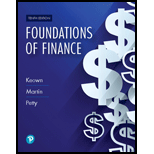
(Divisional costs of capital and investment decisions) In May of this year Newcastle Mfg. Company’s capital investment review committee received two major investment proposals. One of the proposals was issued by the firm’s domestic manufacturing division, and the other came from the firm’s distribution company. Both proposals promise a
However, managers have long recognized that the manufacturing division is significantly more risky than the distribution division. In fact, comparable firms in the manufacturing division have equity betas of about 1.6, whereas distribution companies typically have equity betas of only 1.1. Given the size of the two proposals, Newcastle’s management feels it can undertake only one, so it wants to be sure that it is taking on the more promising investment. Given the importance of getting the cost of capital estimate as close to correct as possible, the firm’s chief financial officer has asked you to prepare cost of capital estimates for each of the two divisions. The requisite information needed to accomplish your task follows:
- The cost of debt financing is 8 percent before a marginal tax rate of 21 percent. You may assume this cost of debt is after any flotation costs the firm might incur.
- The risk-free rate of interest on long-term U.S. Treasury bonds is currently 4.8 percent, and the market-risk premium has averaged 7.3 percent over the past several years.
- Both divisions adhere to target debt ratios of 40 percent.
- The firm has sufficient internally generated funds such that no new stock will have to be sold to raise equity financing.
- a. Estimate the divisional costs of capital for the manufacturing and distribution divisions.
- b. Which of the two projects should the firm undertake (assuming it cannot do both due to labor and other nonfinancial restraints)? Discuss.
Want to see the full answer?
Check out a sample textbook solution
Chapter 9 Solutions
Foundations Of Finance
- I need help with this situation and financial accounting questionarrow_forwardRemaining Time: 50 minutes, 26 seconds. * Question Completion Status: A Moving to the next question prevents changes to this answer. Question 9 Question 9 of 20 5 points Save Answer A currency speculator wants to speculate on the future movements of the €. The speculator expects the € to appreciate in the near future and decides to concentrate on the nearby contract. The broker requires a 2% Initial Margin (IM) and the Maintenance Margin (MM) is 75% of IM. Following € Futures quotes are currently available from the Chicago Mercantile Exchange (CME). Euro (CME)- €125,000; $/€ Open High Low Settle Change Open Interest June 1.2216 1.2276 1.2175 1.2259 -0.0018 Sept 1.2229 1.2288 1.2189 1.2269 0.0018 255,420 19,335 In addition to the information provided above, consider the following CME quotes that are available at the end of day one's trading: Euro (CME) - €125,000; $/€ Open High Low June 1.2216 Sept 1.2229 1.2276 1.2288 Settle Change Open Interest 1.2175 1.2176 -0.0083 255,420 1.2189…arrow_forwardI need help with this problem and financial accounting questionarrow_forward
 EBK CONTEMPORARY FINANCIAL MANAGEMENTFinanceISBN:9781337514835Author:MOYERPublisher:CENGAGE LEARNING - CONSIGNMENT
EBK CONTEMPORARY FINANCIAL MANAGEMENTFinanceISBN:9781337514835Author:MOYERPublisher:CENGAGE LEARNING - CONSIGNMENT Intermediate Financial Management (MindTap Course...FinanceISBN:9781337395083Author:Eugene F. Brigham, Phillip R. DavesPublisher:Cengage Learning
Intermediate Financial Management (MindTap Course...FinanceISBN:9781337395083Author:Eugene F. Brigham, Phillip R. DavesPublisher:Cengage Learning

